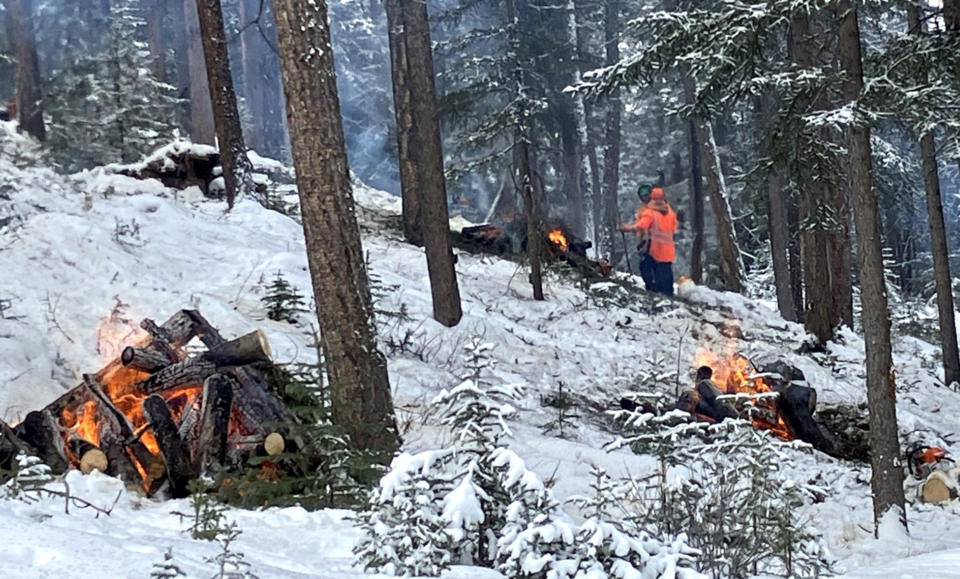BANFF – Banff is moving to regulate use of more fire-resistant building and landscaping materials, including allowing metal roofs for the first time, in a bid to reduce the wildfire threat to the national park townsite.
On Monday (Jan. 27), council gave first reading to land use bylaw amendments, which include updates to the Banff design guidelines to be more FireSmart and a change to a fire risk zone map to reflect higher wildfire hazard town-wide. A public hearing has been set for Feb. 24.
The Town’s planning department and fire department were for years at odds over Banff’s design guidelines – established in 1991 to address issues of development quality – but planning officials say they have been modified over time to address emergent issues.
Darren Enns, the director of planning and environment for the Town of Banff, said wildfire behaviour has changed with climate change and the proposed updates to the design guidelines are responding with public policy to match.
“On the wildfire front, it’s fair to say we’ve shifted from a speculative series of language to more of a destiny-type of language where this is an expectation and not a chance – so this is something that’s a big shift,” he said.
Fears over the threat of wildfire to Banff and other communities in the Bow Valley have intensified following the out-of-control blaze that ripped through Jasper last summer, forcing the evacuation of approximately 5,000 residents and 20,000 tourists.
Despite heroic efforts of firefighters, walls of flames reaching 100 metres high ripped through the national park on the night of July 24, destroying one-third of the Jasper townsite’s buildings and burning about 32,722 hectares.
Officials say the placement and materials used in building construction and landscaping can help hinder the speed and distance of wildfire spread, particularly in relation to flying embers that have been shown to spot many kilometres.
Under the proposed changes to the Banff design guidelines, new roofs or those being replaced must be ranked Class A, which is a rating that is the most resilient to fire. Standing seam metal roofs would be outright permitted for the first time in the town’s history.
“This is a type of roof that was prohibited or discouraged over the length of our design guidelines since the early 1990s and we are now proposing to permit that style of roof within the Town of Banff,” said Enns.
Enns said changes to landscape guidelines are being proposed to address flammability concerns, which essentially come down to the proximity of trees and shrubs near buildings as well as the types of species planted.
“If I was to sum it up … keep your coniferous trees away from your buildings is the summation,” he said. “We learned a lot from recent fire events that combustible species located adjacent to buildings were a primary source of ignition in a lot of cases.”
As part of the process, the wildfire risk map in the land use bylaw is also being updated.
Currently, the map has low, medium, and high-risk fire zones that assume the middle of town had a lower risk of wildfire compared to the periphery of town, but Enns said the plan is to recognize the entire townsite is a high-risk zone.
“We’re proposing to change that model to reflect that the town does not have low, medium and high-risk zones anymore,” he said. “We have a high-risk zone and that’s the entire townsite and that has implications for the types of materials we use for buildings.”
There is also a revamped list of approved plant species and, for the first time, a list of those prohibited.
While the proposed list deals with FireSmart principles, it is also based on years of feedback from Parks Canada about some trees attracting wildlife to town.
The proposed list bans apple, crabapple, mountain ash and plum trees – all proven to draw bears to the townsite in search of an easy meal.
“We had evidenced-based rationale in terms of bears in crabapple trees – it just makes no sense to plant a crabapple tree in Banff anymore,” Enns said.
While the proposed land use bylaw changes intend to address building materials and landscaping on a go-forward basis, the Town of Banff is looking at amendments to the community standards bylaw to address property maintenance practices. That could include, for example, requiring removal of dead trees and shrubs; maintenance and pruning of trees and shrubs; firewood storage; grass maintenance with respect to fire risk; and power line-related vegetation maintenance.
“We are looking at what we can do in our community standards bylaw which deals with the upkeep and maintenance of properties and that could apply to FireSmart principles that are more of ongoing property maintenance aspects,” Enns said.
The next step before the public hearing is to send the proposed land use bylaw amendments to Parks Canada and the municipality’s legal team for vetting.
Mayor Corrie DiManno said she encourages residents to review the proposed changes and give feedback at the public hearing.
“It’s imperative that we move with urgency in updating our design guidelines to be as FireSmart as possible,” she said. “These guidelines will help to bolster our wildfire mitigations and will help to protect our town.”
DiManno said adaptations have to be made to the very real impacts of climate change.
“While some of these changes might not be the most aesthetically pleasing they will be what helps protect us in the event of a wildfire, and so I really appreciate we are able to move through those inherent tensions of wanting Banff to look beautiful as well as to be as fire-proof as possible,” she said.




